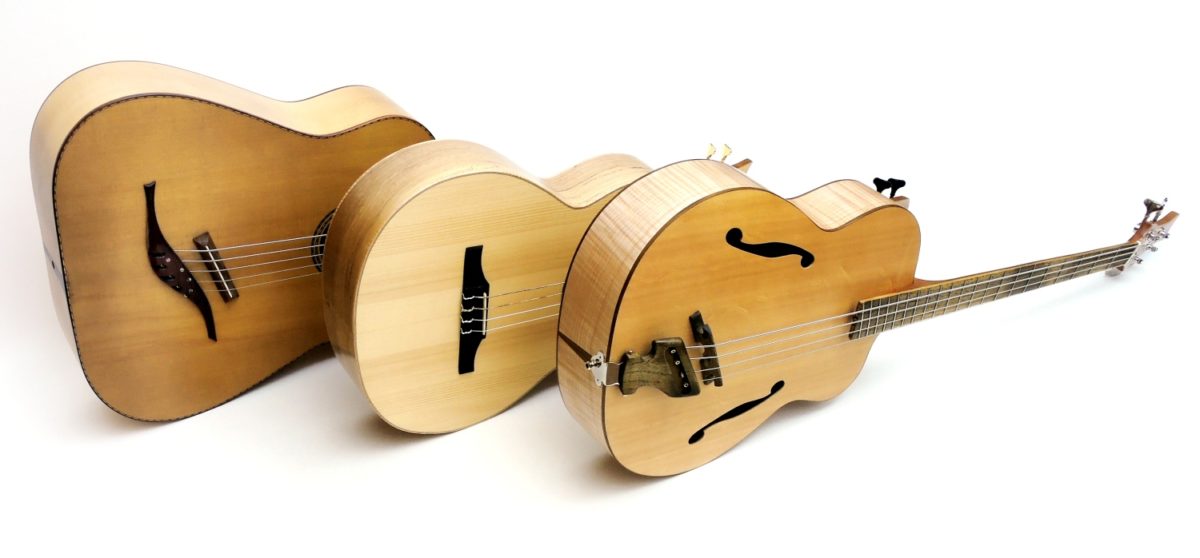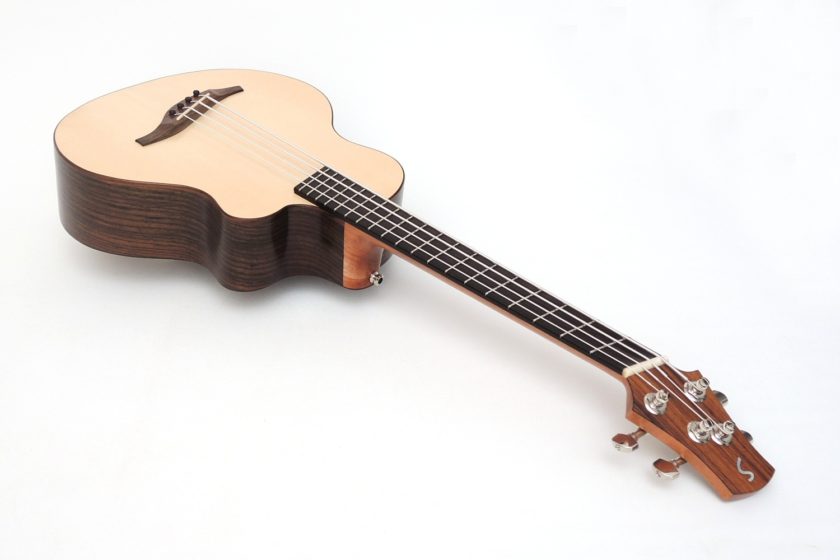Bass gives music direction and soul. Therefore, bass instruments have always been important in the interplay of instruments. The first thing that comes to mind is, of course, the double bass of the classical orchestra. But there are also basses in other ensembles.
Acoustic Basses Overview
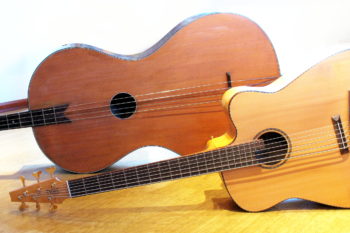
For example, many mandolin orchestras traditionally have an upright bass that looks like a very large, elongated guitar with a small, centrally placed sound hole (fig. 1). The basses of the tamburizza ensembles in the Balkans look very similar. With the Balalaikas, the bass is simply a huge, also typically triangular, Balalaika (fig. 2), and in the classical guitar orchestra the bass part is usually played by enlarged nylon string guitars. In Mexico there is the guitarrón, which is the main rhythm instrument in mariachi bands.
Development of Acoustic Basses
The first acoustic bass guitars with steel strings appeared in the 1960s/70s, but could not really make their mark at that time. It wasn't until the unplugged wave of the late 1980s that acoustic basses as we know them today became accepted by a wider audience. At first, there were only handcrafted one-offs. They were not yet an option in the guitar industry.

The development work for the new types of basses was clearly done by the individually working guitar builders, pioneers who burned for their profession and dared to do something new without regard to business arguments (fig. 3). The "big players" could not afford to experiment with such new concepts because, from a cost-benefit perspective, the target group was too small to make expensive new developments worthwhile. Only when the pioneering work was done, the industry brazenly took over the developments of the guitar builders in whole or in part.
Today, the small, guitar-like basses that you can barely hear are still on the market, but more acoustically usable instruments are now coming from the industry.
Sound
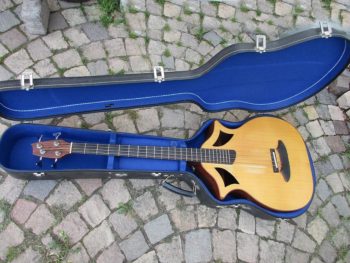
The sound of the double bass is often cited as a benchmark for acoustic basses. If this is the goal, an instrument with a large capacity is required. Only a corresponding volume can really represent the low tones sonorously. The strings play an important role too. A roundwound string always sounds more treble accentuated and dynamic than one wound with flat wire or nylon tape.
Steel strings develop a different dynamic than nylon strings, and the construction of the bass must also be aligned to the strings. If a bass built for steel strings is equipped with nylon strings, it usually becomes less loud. Contrariwise, the high-tension steel strings would sooner or later destroy the nylon string instrument. With the acoustic bass, just as with the electric bass, the bassist can determine his playing preferences by deciding whether the fingerboard should be fretless or fretted.
Construction of Acoustic Basses
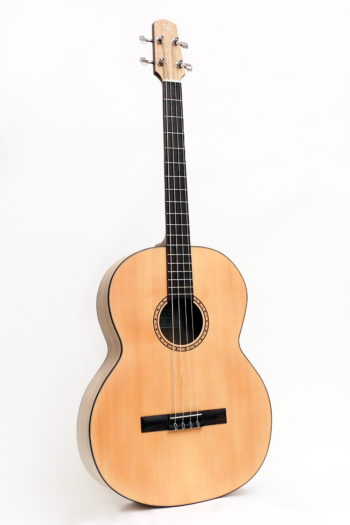
When choosing an acoustic bass, special attention should be paid to the construction. As already mentioned, the lower the bass is supposed to sound, the larger the volume of the body has to be. If the focus of the desired frequencies is more in the low-mid range, the body can be constructed smaller accordingly.
The thicker the string, the longer it must be in order to vibrate properly. This becomes particularly clear with the low E-string or the B-string of the 5-string. For both, the normal electric bass scale length of 864 mm is often too short.
Especially with basses it is important to find the perfect balance between stability and vibration capacity in the top construction. A top that is too thick or has too much bracing is often not capable of producing a supporting bass tone. If it is too weak, it will quickly deform or crack. Likewise, the depth of the body plays a significant role in bass development. A bass with a slender body may play comfortably, but will always have weaknesses in the low frequencies.
With the positioning of the sound hole one can influence very well the effective vibrating surface of the soundboard. If the sound hole, which is supposed to be rigid, is moved e.g. to the side or next to the fingerboard, the soundboard surface can be used more efficiently for vibrating, which has a positive effect on the basic tonality and the volume (fig. 3).
The bridge position depends on the overall construction. For optimal sustain, however, the bridge belongs in the center of the top, as it does with the classical guitar. Center is defined as the center of the top in the lower bout. If, on the other hand, you want more percussive sounds, you can place the bridge close to the end of the body, for example. An advantage of this design is that the neck extends further into the body and the fretting arm does not have to be stretched as far to play in the lower registers.
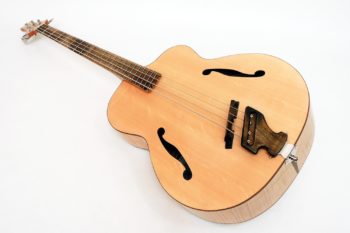
With acoustic basses, the strings can be attached either to the top (fig. 4) or behind the top (fig. 5). The first variation causes the soundboard to vibrate via a combination of tension and pressure of the strings on the bridge. This makes the sound direct, dynamic and more like the sound of a guitar. With the second variation, that is, when the tailpiece is placed at the bottom on the tailblock, the transmission of vibration results only from pressure. This design entails some consequences in the construction. In order to build up enough pressure, the bridge must be relatively high, which in turn means that the neck must be angled more towards the back. but the higher the bridge, the more indirect the tone. A good example of this is the double bass. Due to the height of the bridge, the strings are very far from the top. As the vibration is transported longer over the bridge to the soundboard, the instrument reacts slower and more majestic. If this construction method is used, a slow response can also be produced on the acoustic bass, if such a sound is desired.
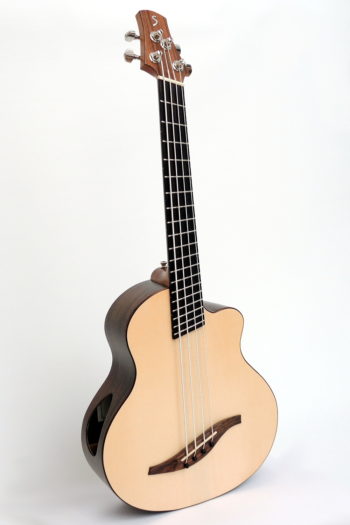
Another parameter that can influence the timbre and frequency range is the choice of wood. A bass that seems loud when played acoustically alone may be lost in the context of the band. The reason for this can be, that the wood better reproduces those frequency ranges that we hear particularly well. However, these are usually occupied by the guitars and are therefore not easily distinguishable in the ensemble. Different resonance woods cover different frequency ranges. So the choice of wood for back and sides can make a difference to the frequency range of the other instruments involved. Which wood is suitable for interplay can best be answered by an experienced guitar maker.
New Developments
What I have described so far is the "classic" approach to building acoustic basses. The development of the acoustic guitar, and I include bass guitars in this, is not yet finished. As one of the pioneers in the field of acoustic basses, the subject always excites me. Recently, I created an archtop bass (fig. 5) that partially refutes the insights of sound production described here. The interaction of the arched top and the Curved Double-A-Bracing, developed specifically for this bass, ensures that, despite the relatively small body, the low frequencies are reproduced excellently.
Intended Purpose
For purely acoustic applications, e.g. street music, barbecue, salon music, etc., there is no way around a professional acoustic bass and I would recommend to visit a luthier. He can respond to the individual sound ideas and advise in terms of size and playability. For a bass in the mid-frequency range, the body, as already mentioned, does not have to be that much larger than that of a guitar.
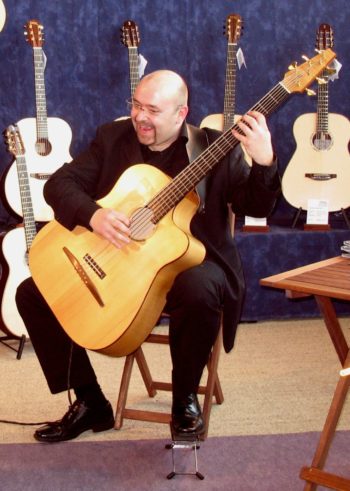
If you only need acoustic bass sound from time to time and have no problems with amplifiers, an industrially manufactured acoustic bass can be a good choice.
In some circumstances, even a bass ukulele (fig. 6) will suffice. bass ukuleles are available with nylon strings or silicone rubber strings. On a very small scale, these also work acoustically, but as a rule they need amplification.
However, if you do not want to do without the highest sound quality despite only occasional use, there is no way around going to a luthier.
Playing Comfort
Basically, a serious craftsman should pay attention to the playability of his instruments. For people who are afraid of a large body, the guitar maker has a few extra tricks up his sleeve with which he can remedy the situation. For example, there is the bevel, which rounds off the lower bout on the upper side and thus relieves the right arm, one can also make a groove on the back of the body so that it fits better to the body. Often asymmetrical depth in the body is enough, that is, the bass side of the body is constructed more flat than the treble side. This way a wedged shape is achieved. This is the traditional Spanish method, obtaining that the body leans towards the player. However, if you are used to the classical guitar posture, you can basically manage with any body size (fig. 7).

